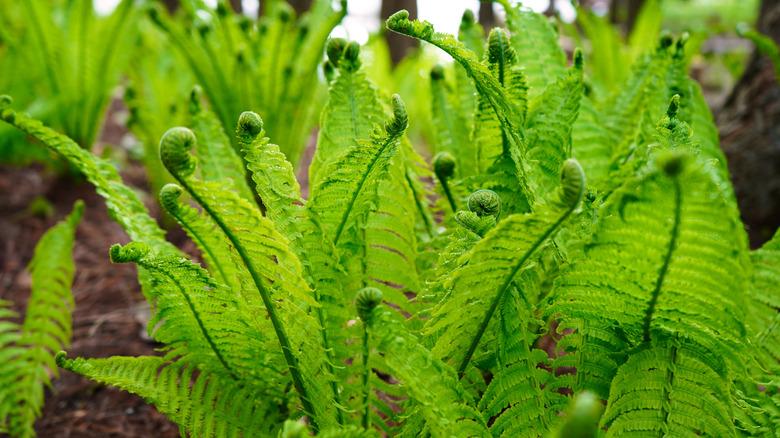Fill Patchy Spots In Your Lawn With A Reliable Shade-Loving Ground Cover
It's a familiar story: You sow seeds in the spring, watch them sprout into a healthy lawn by June or July, but then it turns brown during the heat of the summer and fails to return the following year. Let's face it, most grasses need lots of sun. Scotts states that even the best grass seed for shade needs at least four to six hours of sun a day. That's because without enough sun, grasses don't develop a strong enough root system to withstand periods without much rain. If that's happened to you, it's probably time to try some ground covers that can thrive in lower light. One idea is to turn to ferns.
In fact, North American hardy ferns might be your best alternative. They are adapted to low-light environments, and being native to North America, they require little maintenance once established and can live indefinitely. Per the American Fern Society, they are some of the oldest plant species on Earth. With hundreds of different varieties of native ferns,you have a lot of choices with different sizes, shapes, and textures. Though they grow taller than other ground covers, ferns are often recommended to fill a shady spot. They won't produce flowers – they reproduce by spores and rhizomes rather than seeds – but their soft textures and graceful fronds can have a soothing effect on your eyes.
Popular ferns to grow in shaded areas
One hardy type to consider is the ostrich fern (Matteuccia struthiopteris). It grows well in U.S. hardiness zones 3 through 7, and can grow 4 to 6 feet in height. It prefers consistently moist soil and even tolerates wet soils. So, in other words, plant it in an area that doesn't dry out. Christmas fern (Polystichum acrostichoides) is a showy plant growing 1 to 2 feet tall in zones 3 to 9. It can tolerate more sun and drought than other varieties, and prefers well-draining soil of medium moisture. Since it doesn't spread, plant several to fill a space. Hay-scented fern (Dennstaedtia punctilobula) is hardy in zones 3 to 8 and continues to grow throughout the year, and can be up to 2 feet tall. It colonizes easily, but you should thin the plants if they are crowding out others. Cinnamon fern (Osmundastrum cinnamomeum) is an attractive plant that will grow up to 4 feet in height in zones 4 to 9. Let it fill a low, moist area, as it grows naturally along creek beds and in wetlands. It can tolerate a wide range of sun exposure, from deep shade to full sun.
Caring for ferns is relatively simple. Plant them in the right place, water them until they are well established, and cut them back when their fronds die back. Native ferns are generally disease- and deer-resistant, and you can easily propagate ferns from clippings. Swapping out grass for ferns requires a little thinking outside the box when it comes to lawn care, but you will also swap out annual frustration for years of delight.

